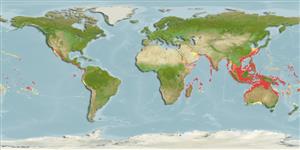Teleostei (teleosts) >
Carangiformes (Jacks) >
Carangidae (Jacks and pompanos) > Caranginae
Etymology: Caranx: French, carangue, the name of a Caribbean fish; 1836 (Ref. 45335).
More on authors: Quoy & Gaimard.
Environment: milieu / climate zone / depth range / distribution range
Ecology
Marine; freshwater; brackish; reef-associated; amphidromous; depth range 0 - 146 m (Ref. 57178). Tropical; 26°C - 29°C; 32°N - 36°S, 25°E - 77°W
Indo-Pacific: Red Sea and East Africa to Hawaii, north to southern Japan and the Ogasawara Islands, south to Australia and New Caledonia. Eastern Pacific: southwestern coast of Baja California Sur, Mexico and the Gulf of California to Ecuador and the Galapagos Islands (Ref. 9283).
Length at first maturity / Size / Weight / Age
Maturity: Lm 42.0 range ? - ? cm
Max length : 120 cm TL male/unsexed; (Ref. 9987); common length : 60.0 cm FL male/unsexed; (Ref. 3287); max. published weight: 18.0 kg (Ref. 9987)
Dorsal spines (total): 9; Dorsal soft rays (total): 19 - 22; Anal spines: 3; Anal soft rays: 14 - 17; Vertebrae: 25. This species is distinguished by the following characters: dorsal profile moderately convex anteriorly; adipose eyelid well developed, moderate anteriorly, posterior eyelid extends onto eye to rear border of pupil; gill rakers (including rudiments) 6-8 + 15-19 = 21-25; straight part of lateral line with 0-3 anterior scales followed by 27-36 strong, dark scutes; breast completely scaly; vertebrae 10+15; upper jaw with outer row of strong canines widely spaced in adults, and an inner band of small villiform teeth, widest at symphysis; on lower limb of first gill arch jaw with a single row of strong conical teeth widely spaced in adults. Colour in life with adults' head and body silvery olive to iridescent blue-green above, silvery olive to whitish below; small blackish spot, much smaller than pupil diameter, at upper angle of opercle (this spot evident on specimens of about 14 cm fork length); second dorsal fin olive to blackish, the lobe with a white tip (white tip becomes more obvious with increasing size) (Ref. 9894).
Adults inhabit coastal and oceanic waters associated with reefs (Ref. 9283, 58302). Pelagic at 1-96 m (Ref. 58302). They are often seen in large daytime schools but solitary at night when feeding (Ref. 90102). During the day they are usually seen milling in stationary aggregations (Ref. 44894), forming slow-moving schools in the passes or outside the reef (Ref. 4795). Juveniles may be encountered in estuaries (Ref. 9283, 44894), occasionally entering rivers and penetrating well inland (Ref. 2847, 44894). Adults feed mainly on fishes, squids and crustaceans (Ref. 9283, Ref. 90102). They are caught mainly on hook-and-line; also with gill nets, purse seines, and other artisanal gear (Ref. 9894). Marketed fresh, dried or salted (Ref. 9283) and frozen (Ref. 9987). Consumed broiled and baked (Ref. 9987).
Life cycle and mating behavior
Maturity | Reproduction | Spawning | Eggs | Fecundity | Larvae
Paxton, J.R., D.F. Hoese, G.R. Allen and J.E. Hanley, 1989. Pisces. Petromyzontidae to Carangidae. Zoological Catalogue of Australia, Vol. 7. Australian Government Publishing Service, Canberra, 665 p. (Ref. 7300)
IUCN Red List Status (Ref. 130435: Version 2024-1)
Threat to humans
Reports of ciguatera poisoning (Ref. 130160)
Human uses
Fisheries: commercial; gamefish: yes
Tools
Can't connect to MySQL database fbquizv2. Errorcode: Too many connections
